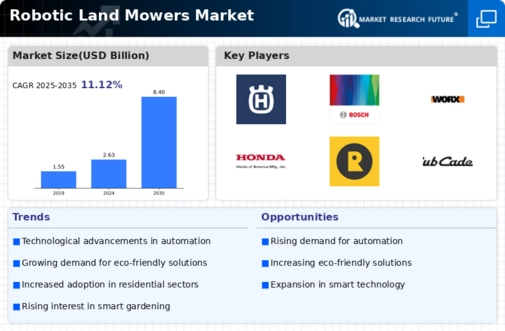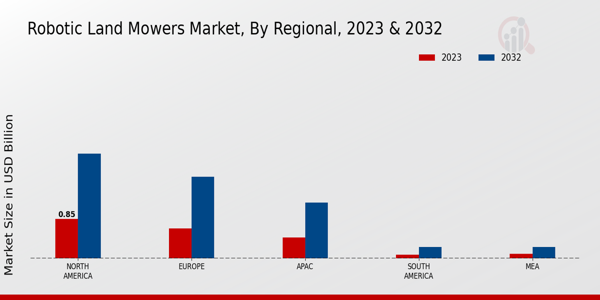Rising Labor Costs
In many regions, rising labor costs are driving the adoption of robotic mowers in the Global Robotic Land Mowers Market Industry. As traditional landscaping services become more expensive, homeowners and businesses are seeking cost-effective alternatives. Robotic mowers offer a solution by reducing the need for manual labor while maintaining lawn quality. This trend is particularly evident in urban areas where labor shortages are common. The projected growth of the market to 8.4 USD Billion by 2035 underscores the potential for robotic mowers to fill this gap. Consequently, the demand for these automated solutions is likely to increase as consumers prioritize cost savings.
Urbanization Trends
Urbanization is a significant driver of the Global Robotic Land Mowers Market Industry, as more people move to cities and suburban areas. This demographic shift leads to increased demand for efficient lawn care solutions that fit into smaller living spaces. Robotic mowers are particularly appealing to urban dwellers who may lack the time or resources for traditional lawn maintenance. The convenience of automated mowing allows homeowners to maintain their lawns effortlessly, making these products attractive in densely populated areas. As urbanization continues, the market is poised for growth, with an expected valuation of 8.4 USD Billion by 2035.
Market Growth Projections
The Global Robotic Land Mowers Market Industry is on a trajectory of significant growth, with projections indicating a rise from 2.63 USD Billion in 2024 to 8.4 USD Billion by 2035. This growth is driven by various factors, including technological advancements, rising labor costs, and increasing consumer demand for automation. The expected CAGR of 11.13% from 2025 to 2035 highlights the market's potential for expansion. As more consumers and businesses recognize the advantages of robotic mowers, the industry is likely to see an influx of new entrants and innovations, further enhancing its competitive landscape.
Technological Advancements
The Global Robotic Land Mowers Market Industry is experiencing rapid technological advancements that enhance the efficiency and effectiveness of robotic mowers. Innovations such as GPS navigation, obstacle detection, and AI-driven algorithms are becoming increasingly prevalent. These technologies allow for precise mowing patterns and improved battery life, which are crucial for consumer satisfaction. As of 2024, the market is valued at 2.63 USD Billion, indicating a growing acceptance of these advanced features among consumers. The integration of smart home technology further supports this trend, as robotic mowers can now be controlled via smartphones, appealing to tech-savvy homeowners.
Environmental Sustainability
The Global Robotic Land Mowers Market Industry is increasingly influenced by the growing emphasis on environmental sustainability. Robotic mowers are designed to operate with minimal energy consumption and reduced emissions compared to traditional gas-powered mowers. This aligns with global efforts to promote eco-friendly practices in landscaping and gardening. Furthermore, many robotic mowers utilize mulching technology, which returns nutrients to the soil, enhancing lawn health without the need for chemical fertilizers. As consumers become more environmentally conscious, the demand for sustainable mowing solutions is expected to rise, contributing to the market's projected CAGR of 11.13% from 2025 to 2035.
Consumer Preferences for Automation
The Global Robotic Land Mowers Market Industry is witnessing a shift in consumer preferences towards automation and convenience. As lifestyles become busier, homeowners are increasingly seeking solutions that save time and effort in lawn maintenance. Robotic mowers cater to this demand by offering automated mowing schedules and remote control features. This trend is particularly pronounced among younger generations who value technology and efficiency. The market's growth is reflected in the projected CAGR of 11.13% from 2025 to 2035, as more consumers recognize the benefits of robotic mowers. This shift in preferences is likely to drive further innovation and product development in the industry.













